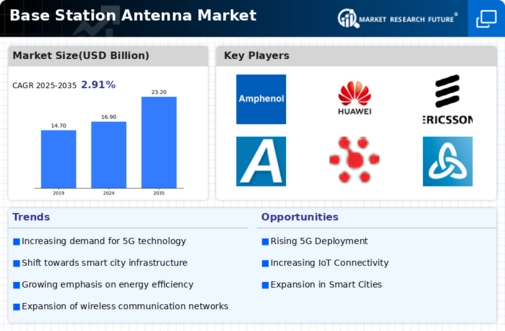Market Growth Projections
The Global Base Station Antenna Market Industry is poised for substantial growth, with projections indicating a market size of 16.9 USD Billion in 2024 and an anticipated increase to 23.2 USD Billion by 2035. This growth trajectory suggests a compound annual growth rate (CAGR) of 2.91% from 2025 to 2035. The expansion is driven by various factors, including the rising demand for mobile connectivity, technological advancements, and government initiatives. As the telecommunications landscape evolves, the market is likely to adapt to new challenges and opportunities, positioning itself for sustained growth in the coming years.
Rising Demand for Mobile Connectivity
The increasing demand for mobile connectivity is a primary driver of the Global Base Station Antenna Market Industry. As more consumers rely on mobile devices for communication and internet access, the need for robust infrastructure becomes evident. In 2024, the market is projected to reach 16.9 USD Billion, reflecting a growing investment in base station antennas to support enhanced connectivity. This trend is particularly pronounced in urban areas, where population density necessitates more base stations to ensure reliable service. The expansion of 5G networks further amplifies this demand, as higher frequencies require advanced antenna technologies to deliver optimal performance.
Government Initiatives and Investments
Government initiatives and investments play a pivotal role in shaping the Global Base Station Antenna Market Industry. Many countries are prioritizing the expansion of telecommunications infrastructure to boost economic growth and improve connectivity. For instance, various governments are allocating funds for the deployment of 5G networks, which necessitates the installation of new base station antennas. These initiatives not only enhance mobile connectivity but also stimulate job creation in the telecommunications sector. As a result, the market is likely to experience steady growth, with a projected CAGR of 2.91% from 2025 to 2035, reflecting the positive impact of government support on infrastructure development.
Emerging Markets and Urbanization Trends
Emerging markets and urbanization trends are significant factors influencing the Global Base Station Antenna Market Industry. As developing countries continue to urbanize, the demand for telecommunications infrastructure rises sharply. Urban areas typically experience higher mobile usage, necessitating the deployment of additional base stations to ensure adequate coverage and service quality. Countries in Asia-Pacific and Africa are witnessing rapid urban growth, leading to increased investments in base station antennas. This trend is expected to sustain market growth, as the need for improved connectivity in these regions drives the demand for advanced antenna solutions.
Technological Advancements in Antenna Design
Technological advancements in antenna design significantly influence the Global Base Station Antenna Market Industry. Innovations such as MIMO (Multiple Input Multiple Output) technology and beamforming techniques enhance the efficiency and performance of antennas. These developments allow for better signal quality and increased capacity, which are crucial for meeting the demands of modern telecommunications. As a result, manufacturers are investing in research and development to create antennas that can support emerging technologies like 5G and IoT. This focus on innovation is expected to contribute to the market's growth, with projections indicating a rise to 23.2 USD Billion by 2035, driven by the need for advanced solutions.
Growing Internet of Things (IoT) Applications
The proliferation of Internet of Things (IoT) applications is driving the Global Base Station Antenna Market Industry. As more devices become interconnected, the demand for reliable and efficient communication networks increases. Base station antennas are essential for supporting the vast number of IoT devices that require constant connectivity. Industries such as smart cities, healthcare, and transportation are increasingly adopting IoT solutions, which in turn fuels the need for enhanced antenna systems. This trend is expected to contribute to the market's growth, as businesses and governments invest in infrastructure to accommodate the rising number of connected devices, thereby expanding the overall market landscape.

























Leave a Comment